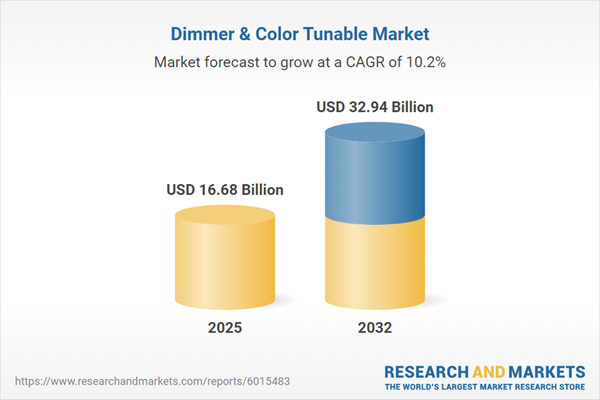Speak directly to the analyst to clarify any post sales queries you may have.
The dimmer and color tunable market is undergoing rapid transformation as organizations increasingly pursue automated, adaptive lighting solutions in commercial, residential, and industrial environments. Decision-makers require in-depth perspectives that capture the interconnected influence of technology, regulation, and end-user demand to fully leverage new growth opportunities across global lighting controls.
Market Snapshot: Dimmer & Color Tunable Market Size and Growth
The global dimmer and color tunable market grew from USD 15.12 billion in 2024 to USD 16.68 billion in 2025. It is projected to expand at a compound annual growth rate (CAGR) of 10.21%, reaching USD 32.94 billion by 2032. This trajectory underscores sustained demand among businesses, cities, and institutions seeking both energy efficiency and enhanced lighting management.
Scope & Segmentation: Comprehensive Market Coverage
This report delivers a structured analysis across multiple dimensions, equipping leaders to target opportunities with precision.
- Application: Commercial, Industrial, Residential
- Technology: Halogen-Based, Incandescent-Based, LED-Based
- Product Type: Color Tunable Drivers, Smart Dimmers, Wireless Dimmers
- Distribution Channel:
- Offline: Electrical Wholesalers, Specialized Retailers
- Online: Company Websites, E-Commerce Platforms
- Control Type: App-Based Control, Manual Control, Remote Control, Sensor-Based Control
- Installation Type: New Installation, Retrofit
- Regional Scope:
- Americas: United States, Canada, Mexico, Brazil, Argentina, Chile, Colombia, Peru
- Europe, Middle East & Africa: United Kingdom, Germany, France, Russia, Italy, Spain, Netherlands, Sweden, Poland, Switzerland, United Arab Emirates, Saudi Arabia, Qatar, Turkey, Israel, South Africa, Nigeria, Egypt, Kenya
- Asia-Pacific: China, India, Japan, Australia, South Korea, Indonesia, Thailand, Malaysia, Singapore, Taiwan
- Key Companies Profiled: Signify N.V., ams OSRAM AG, Lutron Electronics Co., Inc., Acuity Brands, Inc., Legrand SA, Eaton Corporation plc, Schneider Electric SE, Hubbell Incorporated, Crestron Electronics, Inc., Delta Electronics, Inc.
Key Takeaways: Strategic Insights for Decision-Makers
- Transition to digital, networked lighting controls is enabling adaptive environments and aligning building operations with sustainability mandates.
- Increasing integration of IoT and smart building platforms is making lighting solutions more data-driven and responsive to occupancy and energy needs.
- Product differentiation now relies on robust control interfaces, modular architectures, and seamless compatibility with building management systems.
- Lifecycle benefits, including reduced operational costs and regulatory compliance, are positioning dimmers and color tunable drivers as central to green building initiatives.
- Competitive strategies include platform convergence, vendor collaboration, and selective acquisitions in sensor and analytics technology to accelerate innovation.
- Regional adoption patterns are heavily influenced by local regulatory frameworks; aligning product offerings to these nuances supports market penetration and sustained value creation.
Tariff Impact: U.S. Market Considerations
New 2025 U.S. tariffs on electronic components and materials have prompted manufacturers to adjust procurement and supply chain strategies. Many firms are exploring nearshore manufacturing and component standardization to offset rising costs while maintaining innovation and delivery timelines.
Methodology & Data Sources
This report applies a hybrid research approach, combining in-depth executive interviews and end-user feedback with quantitative analysis of market trends, patent activity, and regulatory changes. Extensive secondary research—including white papers and standards documentation—augments primary insights, and robust scenario testing across segmentation ensures consistency and relevance.
Why This Report Matters
- Empowers strategic investment and product planning by revealing growth drivers and competitive shifts in the dimmer and color tunable market.
- Informs market entry and regional expansion initiatives by mapping segment-specific trends and regulatory factors.
- Supports risk mitigation and faster time-to-market through actionable supply chain and innovation insights.
Conclusion
With evolving technologies and regional complexities shaping adoption, businesses that harness data, collaboration, and regulatory agility are best placed to lead the next phase of connected lighting. This report equips stakeholders to act decisively and capture the full potential of the market.
Additional Product Information:
- Purchase of this report includes 1 year online access with quarterly updates.
- This report can be updated on request. Please contact our Customer Experience team using the Ask a Question widget on our website.
Table of Contents
3. Executive Summary
4. Market Overview
7. Cumulative Impact of Artificial Intelligence 2025
Companies Mentioned
The companies profiled in this Dimmer & Color Tunable market report include:- Signify N.V.
- ams OSRAM AG
- Lutron Electronics Co., Inc.
- Acuity Brands, Inc.
- Legrand SA
- Eaton Corporation plc
- Schneider Electric SE
- Hubbell Incorporated
- Crestron Electronics, Inc.
- Delta Electronics, Inc.
Table Information
| Report Attribute | Details |
|---|---|
| No. of Pages | 188 |
| Published | October 2025 |
| Forecast Period | 2025 - 2032 |
| Estimated Market Value ( USD | $ 16.68 Billion |
| Forecasted Market Value ( USD | $ 32.94 Billion |
| Compound Annual Growth Rate | 10.2% |
| Regions Covered | Global |
| No. of Companies Mentioned | 11 |









